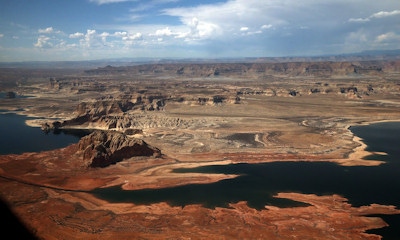October 31, 2016

.jpg?width=150&auto=webp&quality=80&disable=upscale)
Drought is a natural disaster, albeit a slow moving one. The announcement in early summer that closer collaboration between drought resiliency programs at USDA and the Department of Interior would be coming to the Colorado River basin was welcomed by those that depend on the river.
Having endured 16 years of drought and counting, much of the Colorado River basin is in need of this attention. The Colorado River is often called the hardest working river in the West. These challenges to the “mighty Colorado” pose serious risks to everyone and everything that depends on the river – from agriculture to our cities to fish and wildlife to our businesses.

HARD WORKER: The Colorado River is an important Western water source and cooperators are working together to preserve its value.
The welcome collaboration partners the Bureau of Reclamation WaterSMART program and Natural Resources Conservation Service (NRCS) Environmental Quality Incentive Program (EQIP) in the Colorado River Basin. Reclamation will work with irrigation districts, helping to upgrade infrastructure and improve overall efficiency in delivering water to farmers, while NRCS will work with individual farming and ranching operations to make more efficient use of the water delivered.
The renewed commitment to coordination between NRCS and Reclamation advances the philosophy embodied in the Bush-era “Bridging the Headgates” initiative that emphasized technical support from these same agencies in a comprehensive manner. This is a fine example of how good ideas can transcend politics, underscoring that the only solutions lasting beyond the latest and greatest funding program are those that are collaborative in nature, that rise from the bottom-up, with input and support from those most directly impacted.
Role for government
The federal government certainly cannot change the hydrology of the West, but there is a role it can play to support family farmers and ranchers. A successful water shortage strategy must include a “portfolio” of water supply enhancements and improvements, such as water reuse, recycling, conservation, water-sensitive land use planning, and water system improvements. New infrastructure and technologies can help stretch water for all uses. State water laws, compacts and decrees must be the foundation for dealing with shortages.
Coordinated programs like EQIP and WaterSMART can help stretch water supplies, but water conservation alone has its limits. Developing strategic new water storage is necessary insurance against shortages. And, urban growth expansion should be contingent upon sustainable water supplies. Using Western irrigated agricultural water as the “reservoir” of water for municipal growth is not sustainable in the long run and can damage rural communities.
This portfolio of activities for smart, effective management of Western water resources can help decision-makers deal with the harsh realities of current and future water shortages due to drought and over-allocation of water to growing new demands.
Make no mistake; USDA Secretary Tom Vilsack and Interior Secretary Sally Jewell have provided an example of how interests can collaborate in pursuit of a drought resilient future. However, this coordination between Reclamation and NRCS is just one of many critical steps required to develop lasting solutions that will sustain our rural economies, natural resources, communities, and families across Arizona and the West.
Keppen is executive director for the Family Farm Alliance, a west-wide coalition of farmers, ranchers, irrigation districts and allied industries that advocates for reliable and affordable irrigation.
You May Also Like




